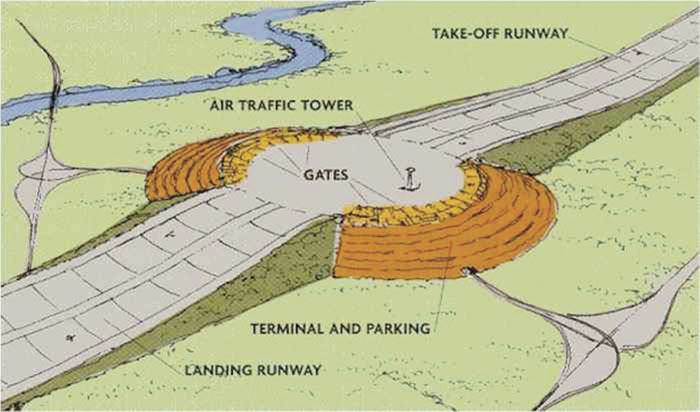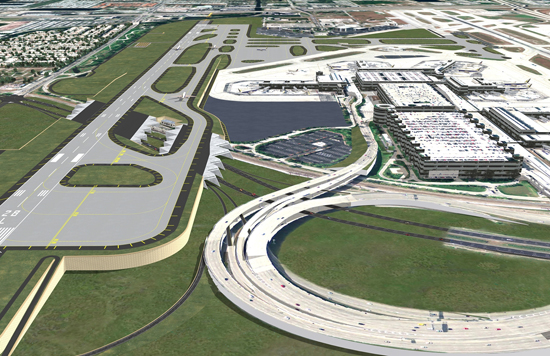The Airport Design Utopian
What ever happened to the Starport, the brainchild of Jim Starry that re-imagined the airport?
/https://tf-cmsv2-smithsonianmag-media.s3.amazonaws.com/filer/starport_patent-hero.jpg)
We study cities and suburbs, agricultural land and wildlife habitat. But airports aren’t really any of these. We study green building techniques, but those techniques usually focus on houses and hotels and office buildings, not airports. We’ve studied the contribution of jet aircraft to air pollution as a function of miles traveled, but not as a result of landing and idling and taking off.
This excerpt comes from an article written by Ed Ayres, published in the July/August 2001 edition of World Watch. Little did anyone know that just a few weeks later, the attacks on the World Trade Center would direct more focus toward airports than ever before, and would cause numerous shifts in their operation. Yet for all the changes to security screening procedures, the flow of car and foot traffic in and around buildings, and the regulations of luggage and liquids, the design of airports has changed little in the last decade.
One reason for this is that airports are rarely built from scratch—Denver International Airport is the only major U.S. hub to have been constructed from the ground up since the mid-1970s (a smaller ground-up project, Panama City-Bay County, opened in 2010). Plenty undergo renovations, expansions, or the addition of new terminals, but these don’t often allow for a wholesale reconsideration of design. According to Jim Starry, the central character in Ayres’s piece, if we took a different approach to orientation, layout, and land use, airport design could facilitate profound improvements in everything from fuel efficiency to public health.
One of the fundamental changes Starry proposes is to construct runways with a very slight incline—a grade of 2-3 percent would enable landing planes to use far less fuel to slow themselves down. Instead of using thrust reversal, they’d take advantage of the gentle climb for speed reduction. To get the most out of this strategy, though, the runway incline would have to run toward the terminal, so that the plane would be at its point of disembarkation when it came to a stop, rather than a few miles away, requiring taxiing (and more fuel burn, and more noise). This way, planes pulling away from the gate could also take advantage of the grade, taking off downhill, picking up more speed through gravity, requiring less fuel and achieving lift-off with less ground distance traveled.

An illustration of the Starport layout
The more Starry’s proposal gets unpacked, the clearer it becomes that optimizing any piece of it can only happen through a systemic redesign of the whole airport. Graded runways mean terminals would need to be built on a small hill, from which all runways slope down. Or better yet, the terminal becomes the hill, and all of the indoor services—check-in desks, baggage claim, food, waiting areas—sit beneath the planes’ parking gates. Passengers would travel up a level to board. Since all good design concepts have multiple benefits, this one would also deliver efficiencies in the form of heat radiating from inside the terminal up to the tarmac, preventing icing in cold climates. And in theory, by decreasing the distance planes must taxi between the gate and the point of lift-off/landing, total emissions would also be reduced, which means fewer particulates floating through nearby neighborhoods, and therefore less respiratory illness among those residents.
In the few articles that have been written about him, Starry comes across like a nutty inventor—hellbent on convincing those in control of the system that his concept would revolutionize the industry and change the world. In some ways, though, this portrayal seems predicated more on how he presents himself than on the soundness of his ideas (one imagines Buckminster Fuller’s ideas seemed pretty wacky in the early 20th century). On examination, the Starport proposal reads like a largely rational set of design recommendations for solving a host of inefficiencies that make aviation a scourge on the environment and public health.
Yet despite the logic, aviation officials have been reluctant to adopt Starry’s ideas, citing questions of safety, construction costs, and potentially suboptimal outcomes for travellers (such as driving several miles through enclosed corridors beneath the runways to reach the terminal). When the Denver International Airport was built, one of Starry’s ideas was incorporated—the construction of containment ponds where spent de-icing fluid (ethylene glycol) could be funneled and held for recycling, rather than dumped, causing groundwater contamination.
But of course if the airport recycles the fluid, they need to purchase less of it from the company that makes it—not a good way to maintain friendly relationships when that same company owns one of the airlines the airport is courting. As the World Watch story tells it, those containment ponds were not used for recycling for long: “One day the ponds were fitted with a 3-foot diameter pipe that carried the used antifreeze about two miles and dumped it into Barr Lake.” Starry claims the lake no longer freezes in winter.
The tale of Starry’s attempts to revolutionize airport design reads somewhat like a Who Killed the Electric Car? scenario, except that the Starport concept was never brought far enough to life that it could have been killed. But like the story of the electric car, its failure to take root and become the default design model seems to have as much to do with its potentially detrimental effects on dominant industries and systems as it does with the concept’s fundamental features.
Scanning the aviation scene today, there are few instances of design that takes advantage of the potential efficiencies Starry’s concept illuminates. In Fort Lauderdale, Florida, a runway expansion currently under construction at the Fort Lauderdale-Hollywood International Airport is a rare example of a runway engineered with a slight incline, but the Broward County Aviation Department did not incorporate a grade for reasons of efficiency. “The runway was designed to work around many site constraints including elevating the runway over a railroad track and highway, allowing taxiway connectors to maintain grade between the runway and taxiway system, and maintaining a safe runway grade in accordance with FAA standards,” says Steven Wiesner, Director of the Airport Expansion Program, “Secondary benefits, like efficiencies gained, are results that flow from the primary design criteria.”

A rendering of the new runway at Fort Lauderdale-Hollywood Int'l Airport, which will rise 6 stories over a roadway
In fact, when drawings of the 6-story rise were revealed to the public, the focus was on concerns about safety with such a non-typical structural approach, and little to no PR language was dedicated to highlighting the possible benefits of a sloping runway. The FAA’s limit on runway steepness (1.5 percent) lies between the Ft. Lauderdale slope (1.3 percent) and the optimal rise proposed by Starry (over 2 percent), which is a big reason why, for the foreseeable future, the optimal airport design—one in which indoor heat melts outdoor ice, and reductions in aircraft taxi distances reduce asthma rates in surrounding neighborhoods—remains a utopian vision.
/https://tf-cmsv2-smithsonianmag-media.s3.amazonaws.com/accounts/headshot/sarah-rich-240.jpg)
/https://tf-cmsv2-smithsonianmag-media.s3.amazonaws.com/accounts/headshot/sarah-rich-240.jpg)